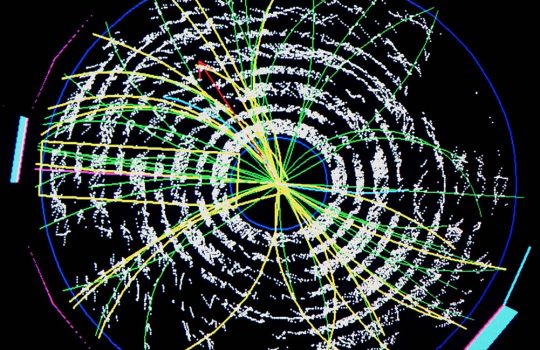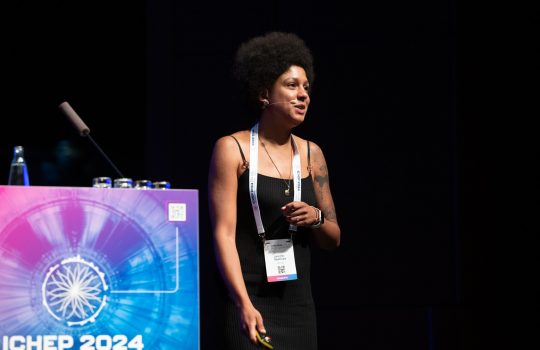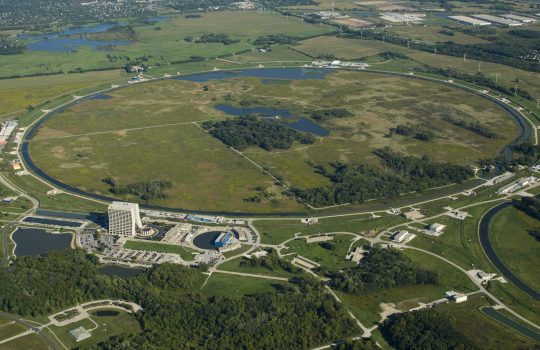BATAVIA, Ill. — Scientists from the Department of Energy’s Fermi National Accelerator Laboratory are presenting new results from experiments performed at the world’s highest-energy particle accelerator during the 32nd International Conference on High Energy Physics in Beijing, China, August 16-22. The physicists from Fermilab and from universities and laboratories around the world traveled to Beijing to present new results from the DZero and CDF experiments.
Collider Run II of the Tevatron began in 2001 after the accelerators and the DZero and CDF detectors completed a major upgrade. Physicists from DZero and CDF are presenting new results on a variety of topics using Run II data, including properties of the top quark, W and Z bosons, bottom and charm mesons, and searches for new physics such as the Higgs boson and extra dimensions.
“New, important physics results are coming out of the Tevatron continuously,” said Fermilab Director Mike Witherell. “Some of these results using Run II data were presented last week at the Tevatron Connection at Fermilab, and are now being presented at Beijing.”
Some of the most exciting results DZero and CDF collaborators are presenting involve measurements of particles called B mesons. Studying the behavior of B mesons — combinations of one bottom quark and one quark of another type (up, down, charm or strange)– may help scientists understand why the universe is made of matter instead of antimatter. The excess of matter, which cannot be explained by the Standard Model, the fundamental theory of particle physics, is one of the greatest unsolved mysteries in our understanding of the universe.
“Both CDF and DZero have the capability to do really precise measurements of B physics that will be complementary to those made at dedicated B factories like BaBar at SLAC and Belle at KEK,” said John Womersley, DZero co-spokesperson. “The Tevatron can also make particles containing bottom quarks that can’t be seen anywhere else.”
Theory predicts that the Bs meson, a combination of a bottom and a strange quark, exists in two different states. The CDF collaboration is presenting a new measurement of the difference in lifetime between the two Bs states. If the new measurement, which is about four times higher than the Standard Model prediction, remains the same after more data is analyzed, it will be an astonishing result that cannot be explained by current theories. DZero is presenting strong evidence for the Bc meson, a combination of a bottom and a charm quark, confirming hints of its existence previously reported by CDF. The Bc can only be produced at the Tevatron, and the new measurements of its mass and lifetime are the most precise in the world.
The CDF and DZero collaborations are both presenting new measurements of the top quark’s mass. The top quark, discovered at Fermilab in 1995, is of great interest to physicists due to its ability to constrain predictions of the mass of the Higgs boson and its possible role in a phenomenon called electroweak symmetry breaking, through which all the particles in the universe attained mass.
“A small change in the mass of the top quark results in a big change in the predicted Higgs boson mass,” said Young-Kee Kim, CDF co-spokesperson. “As we gather more data and reduce the error on the mass of the top quark, many theoretical predictions for electroweak symmetry breaking and other new phenomena will be critiqued and possibly discarded.”
Both collaborations are also presenting new results on the search for exotic phenomena such as extra dimensions and supersymmetry. Fermilab physicists look for particles that can live in extra dimensions, and their effects on particles living in our four dimensions. They also search for particles predicted by the theory of supersymmetry, postulated 30 years ago to solve problems with the Standard Model, such as its inability to include the force of gravity and to explain dark matter. The energies and number of proton-antiproton collisions at the Tevatron allow Fermilab scientists to look for supersymmetric particles that are not accessible at any other experiments. No evidence has yet been seen for extra dimensions or supersymmetric particles, but the collaborations have placed new best-in-the-world limits on the occurrence of these phenomena.
“The new physics results would not have been possible without the terrific performance of our accelerators this year,” said Witherell. “The campaign to improve the accelerators has been very successful, and we are making more improvements for next year.”
Since January 2004, the Tevatron peak luminosity, or the peak number of protons and antiprotons colliding, has increased over 100 percent. The integrated luminosity, or total number of proton-antiproton collisions, exceeded the goals for fiscal year 2004 three months early.
The integration of the Recycler, a novel storage ring for antiprotons, into Tevatron operations has contributed to peak luminosity records in the last couple of months. Protons are much easier to produce than antiprotons, so the smaller number of available antiprotons limits the Tevatron luminosity. Scientists expect even greater increases in luminosity when the Recycler becomes fully operational in the coming year.
“I always had confidence in the very talented people here, but the results from this past year exceeded expectations,” said Roger Dixon, head of Fermilab’s Accelerator Division. “We still have a long way to go to reach our ultimate goal.”
Fermilab is a national laboratory funded by the Office of Science of the U.S. Department of Energy, operated by Universities Research Association, Inc.



